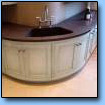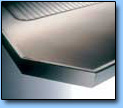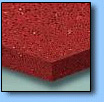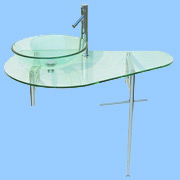Part- 2, All that Jargon;
What is the difference between all the
materials used in the manufacture of a kitchen?
Granite:
 One of the oldest and hardest rock types, many granites were formed 1 billion years before the first dinosaur walked the earth.
One of the oldest and hardest rock types, many granites were formed 1 billion years before the first dinosaur walked the earth.
Granite is an igneous rock. It is formed as a result of the slow crystallisation of molten magma at depth in the earth′s crust. The crystal size of granite varies, the size depending on the time the granite took to cool. The larger the crystals the longer it took to cool. Uplift and erosion has over millions of years resulted in this material outcropping at the surface. The minerals which make up granite are composed primarily of three different types. These minerals are easy to see due to their different colours. The white mineral grains found in granite are feldspar. It is the most abundant mineral found in granite. The light grey, glass-like grains are quartz, and the black, flake-like grains are biotite or black mica. It is the size, distribution and precise chemistry of these minerals which give the granite it′s colour.
Granite is primarily made of Feldspar (65-90%), Quartz (10-60%), Biotite Mica (10-15%), and a small amount of Potassium. Contains very little calcite, if any. Provides a heavy crystalline and granular appearance with mineral grains. It is very hard material and easier to maintain than marble. Yet, it is still porous and will stain. There are different types of granite depending on the percentage mix of quartz, mica and feldspar. Black granite is known as an Anorthosite. It contains very little quartz and feldspar and has a different composition than true granite.
In the course of the many of millions of years it takes to form natural stone materials, considerable variations occur in the colour, texture, density and veining of the natural granite, marble and stone and for this reason close uniformity of appearance is not natural and should not be expected. Colour variations, black spots, spar & shrinkage lines & veining should be expected. If you are very precise as to how your granite should look, the option to pick your own slab before it is cut can be an option.
Granite worktops are one of the hardest and most hardwearing of all the worktop materials. Granite is highly heat resistant and pots and pans can be placed directly on the surface, although only for short periods. Although granite can be slightly porous, it still gives a very durable work surface.
Granite is relatively resistant to scratching, diamond rings will scratch the surface (If you are lucky enough to own one), also some acidic juices and gin can stain granite - so some care is still needed. If staining does occur home care kits are available.
Stainless steel:
Premium quality 18/10 stainless steel is extremely hygienic and co-ordinates with the latest trend in appliances, stainless steel is one of the hardest materials around, but it does scratch. Eventually all the scratches run together and the surface develops a softer finish. Surface scratches in stainless steel rarely have any depth and the sink will obtain a patina with time and the scratching will become less noticeable than when it is new.
Stainless steel requires minimum care. Whether you decide on a polished or a linen finish, your sink will have a very high resistance to heat and to staining, and its smooth, non-porous surface makes it totally practical and hygienic.
 Browsing through our extensive range, you will find that quality stainless steel looks equally good in a traditional, modern or very high-tech setting, since it is a completely versatile material which lends itself to innovative design.
Browsing through our extensive range, you will find that quality stainless steel looks equally good in a traditional, modern or very high-tech setting, since it is a completely versatile material which lends itself to innovative design.
The 18/10 quoted above refers to the proportion of chromium to nickel in the stainless steel alloy.
• For the technically minded:
To be classified as stainless steel, an iron base alloy must contain at least 10.5% of chromium. The presence of chromium enables the steel to form an invisible layer of oxide that protects it against corrosion. If this layer is damaged, a new one forms immediately due to the oxygen content of the air. Increasing the chromium content to 18% has further increased this protection. The addition of nickel to the alloy increased its corrosion resistance while adding a bright polished appearance, hardness, and exceptional resistance to all temperatures. As the nickel level is increased, the quality of the stainless steel is increased. The "top of the line" boast 10% nickel content, is the highest quality available in stainless steel.
Laminate:
Formica laminates easily meet the requirements of BS EN438 1991 Test Method 15, which specifies resistance to staining by 49 substances likely to be encountered in everyday use. Most Formica laminate products have been awarded the Certificate of Hygienic Merit by the Royal Institute of Public Health.
Laminates are resistant to normal everyday exposure to steam and boiling water. High Pressure Laminates, are a resin impregnated decorative paper (which is the pattern and colour of the finished worktop) covered with a final layer of plastic, scratch resistant (which is the surface and also gives texture to the worktop) decorative paper on top. These are glued to the chipboard. There is a wide range of plain colours and patterns, wood grains, stones, hand drawn graphics etc. in either gloss, matt or textured finish.
This type of surface is harder wearing, easy to maintain. and on worktops comes with post forming (bending the Laminate around the edge). Worktop ends are often made of the same material, but this may result in a thin black or cream join showing, particularly on lighter colour surfaces.
Quartz:
Quartz engineered stone is made from an amazing 93% quartz with the remaining 7% polymer binder. The quartz content is pure quartz. The purer the quartz the stronger it is! It will retain its diamond-polished looks for years without needing polishing.
Due to its stain resisting polymers as well as the quartz, it results in a very durable, non-porous chemical resistant worksurface, it has a slight edge for durability compared to granite, so it is extremely ideal for kitchens.
Quartz is one of the most varied minerals, occurring in different types, colours and forms, each with its own unique appearance. It is found in the ground, in sand, in rocks - in nearly every geological environment around the world. It is a crystal with many facets in its original form, giving it a radiance similar to that of diamonds.
It provides rich aesthetics coupled with extraordinary strength and durability.
Glass:
Opticlear glass used in our glass worktops is ′low iron′ and the most optically clear glass available. This means that any colour can be achieved. Regular ′clear′ glass has a higher content of iron, which gives the glass a green tint, therefore only certain colours can be achieved using cheaper clear glass. The colour coating used is guaranteed to adhere to the glass and is unaffected by steam and most caustic agents. All glass in this situation is toughened for safety to meet British Standards.
 Our glass worktops are optically clear, which means that when the back of the glass is colour coated, you will see true colour definition. The glass is toughened where needed for maximum durability and safety.
Our glass worktops are optically clear, which means that when the back of the glass is colour coated, you will see true colour definition. The glass is toughened where needed for maximum durability and safety.
The coating used on the back is so durable that you could leave the product in the worst conditions outside and it would not suffer any damage.
With an extensive background in the kitchen industry we understand the needs and high standards required of the market and can offer the best glass service to satisfy you.
The glass can be cleaned with any form of glass cleaner.
Please contact us to discuss your requirements.
Share this page:




